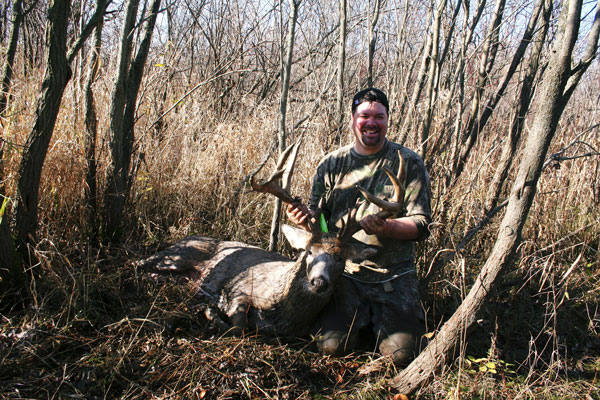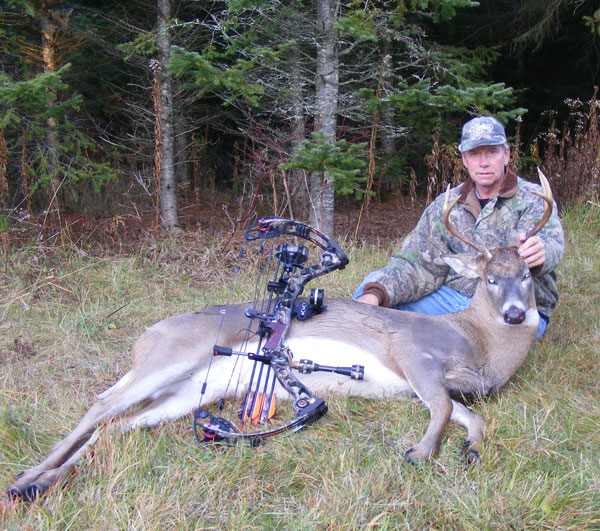In A Rut: Hunting north and south for vulnerable bucks
by Dick Ellis
During the rut or whitetail mating season that moves into high gear from late October though mid-November, bow hunting stories abound across Wisconsin. Now is the time for excruciating, close encounters with monster bucks and success stories of tagging once-in-a-lifetime deer. 2009 has its share of stories, north and south.
Southern Wisconsin
In September, I stood in standing corn in southern Wisconsin during the early goose season waiting for birds. None came, but I listened as Wisconsin hunter Bob Mercier explained his unique deer hunting system that targets dominant bucks during the whitetail rut. Mercier said he has been developing the 4-day system over nine years in the field, and plans on releasing a book on the tactic entitled “Dominance is Everything!- To a monster whitetail buck” prior to March of 2010. Mercier originally told me about the method several years ago but was still researching and writing and not ready to go public.
 [Photo: Bob Mercier used his new system that he developed for use exclusively during the whitetail rut to tag this Waukesha County buck November 5th. The buck had 17 scoreable points, a 19-inch inside spread and great mass and character including a hole in the horn. Mercier has tagged or missed shot opportunities at four other very big bucks utilizing the system over the last decade.]
[Photo: Bob Mercier used his new system that he developed for use exclusively during the whitetail rut to tag this Waukesha County buck November 5th. The buck had 17 scoreable points, a 19-inch inside spread and great mass and character including a hole in the horn. Mercier has tagged or missed shot opportunities at four other very big bucks utilizing the system over the last decade.]
Since 2000, Mercier has only hunted with bow during four consecutive days of the rut, and each year has been able to see what he classifies as the area’s dominant buck within 35 yards of his stand. He claims 100 percent success, and has shared the system with archers of notable reputation under agreements of confidentiality and said each of these hunters has also been successful in tagging or drawing big bucks close using the system.
Although Mercier 2009 hunt was on a 12 acre piece of private property in southern Wisconsin, he said that public land hunters have and will continue to use the system as successfully. Utilizing mock scrapes (man-made imitation of the buck’s ground marking calling-card for female companionship), and scents of both a doe and buck, the system seeks to convince the dominant buck that a breeding pair of deer, meaning a doe in estrus and an intruder buck are in the area. The dominant buck, he said, will then pattern and hunt down the phantom deer (the hunter), seeking to breed with the doe and eject the buck challenging “his” established terrain.
Mercier personally has over the last decade tagged what he believes were the area’s biggest bucks or missed opportunities at the dominant buck he had drawn in close. He has tagged a 20-inch wide nine pointer, another huge nine pointer and missed 10 point and 12 point bucks using the system. “Getting them to come in is what I can teach you,” he said. “I can’t make you a better shot.”
Careful to use human scent eliminators, Mercier’s hunt began on November 3rd. During the planned four days he hunted over his mock scrape and mock tree rubs next to the authentic deer signs with controlled scent drip canisters of both buck and doe set on a defined trail. He hunted virtually all of Tuesday and Wednesday and saw one deer. The target buck, he said, will arrive on any day but usually day three or four and on occasion more than one big buck will arrive at the scrape.
“I always cover my trail with a lure that will attract the buck,” Mercier said. “Remember I am only seeking one buck; the most dominant buck in the area. When you follow the directions the buck will come in during daylight and he will freshen the scrapes giving you a close shot opportunity.”
On November 5th or day three of the system, Mercier had an encounter with a “huge 10-point buck” that stopped short of the mock scrapes and almost beneath the hunter’s treestand did not move for 30 minutes. Mercier had seen the buck previously during the summer and estimated 14-inch tines and an estimated Pope & Young score of 160.
The buck moved to the scrape. Mercier arrow missed what “was the most dominant buck in the area…or so I thought.” He would soon meet, however, the real King of the Forest. Still in the morning hours, Mercier was drawn by the grunting of two bucks and watched as a mammoth animal kicked out another buck and trotted in to where Mercier’s own grunt call brought him to a stop one yard from the mock double scrapes. At 20 yards the shot was true.
Mercier called and asked if this reporter could help drag the buck and take photos. The 17 point non-typical had not traveled far. The buck has a 19-inch inside spread, massive beams, multiple brow tines, tremendous mass, and a unique hole-in-the horn.
“I have had an opportunity to see a dominant buck every time I use the system,” Mercier said. “The system not only works, it takes timing the rut to a new level. The system works in both the bow and gun (late rut) season and has been tested in Wisconsin and Minnesota with 100percent results.”
For immediate information on “Dominance is Everything”, contact Mercier direct at dominanceiseverything@gmail.com or 262-719-2743. In the near future, Mercier’s website will be active. Check it out at www.dominanceiseverything.com
Northern Wisconsin
Dan Flood, an expert archer and this column’s primary consultant in shooting bows and bowhunting, reported “difficult hunting” in Price County on 80 acres of private land, with significantly fewer deer than were seen during recent seasons. Of “1000 pictures” taken since spring by motion cameras set over three food plots, Flood and his brother Jim have seen two fawns, comparatively few does, less bucks and high numbers of bears, including a sow with three young of year cubs and a sow with three yearlings. Neither fawn has been seen since August. Does are easily recognized as individual animals by their frequent visits to food plots and infrequent numbers.
 [Photo: Dan Flood had to hunt long and hard on family property in northern Wisconsin this fall to have an opportunity to tag this six-point Price County buck. Of more than hundreds of field photos taken over food plots on the property this fall, two fawns were captured by three motion cameras. Neither fawn has been seen since August.]
[Photo: Dan Flood had to hunt long and hard on family property in northern Wisconsin this fall to have an opportunity to tag this six-point Price County buck. Of more than hundreds of field photos taken over food plots on the property this fall, two fawns were captured by three motion cameras. Neither fawn has been seen since August.]
Four hunts to the Flood property this fall for several days each trip produced nothing. Previous years the brothers would expect to see two to six deer each sit. “We saw less last year, and we hunt all day and even in the rain,” Flood said. “This was our fourth time up and after two nights and three mornings on stand we were seeing almost nothing. One spike but I was hunting for a bigger buck.”
The Flood brothers were seeing the same three does routinely. Dan Flood tried to “shake things up” by arriving on stand 90 minutes before first light. Ultimately, Jim Flood would tag one of those does and Dan Flood would drop a 6-point buck on the final morning “sneaking in to the clover looking for does”. Both shots were perfect.
“Normally we’ll see 30 to 40 different deer over four hunts during a season,” Dan Flood said. “This year we see a lot of the same deer. If I said we saw nine different deer that is being generous.”
Ellis Hunt
This reporter first bow hunted this season during a hunt in Vilas County November 11 through Saturday morning, November 14. I scouted extensively on day one. Finding few scrapes near stands that normally produces annually and very poor sign including droppings, I moved to different areas of Vilas County. Finding a good scrape line and some droppings, I held vigil for two days on three different stands without seeing a deer.
Believing there are few does in Unit 34, I returned to familiar stands, purchased doe in heat lure, and made drag lines hundreds of yards long strategically placed around scrapes, and travel areas like natural funnels and swamp exit points. My premise was that bucks would be traveling longer journeys in search of female companionship that is more difficult to find. Over 10 hours on stand, I saw one small buck, a six pointer that passed 40 yards from my stand, and a fast moving large animal that I fully believe was a big buck that came to an abrupt halt at my scent line, did not move for 30 minutes, and then slowly and quietly retreated to a swamp.
My report for 21 hours on stands: Two bucks, one probable buck, and no identifiable does seen.







